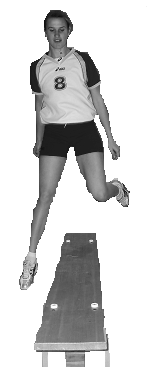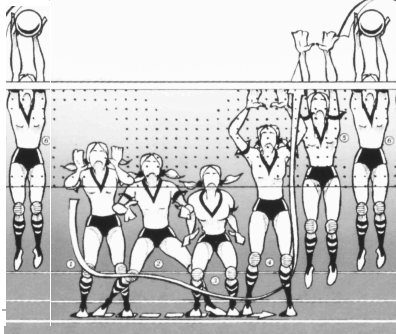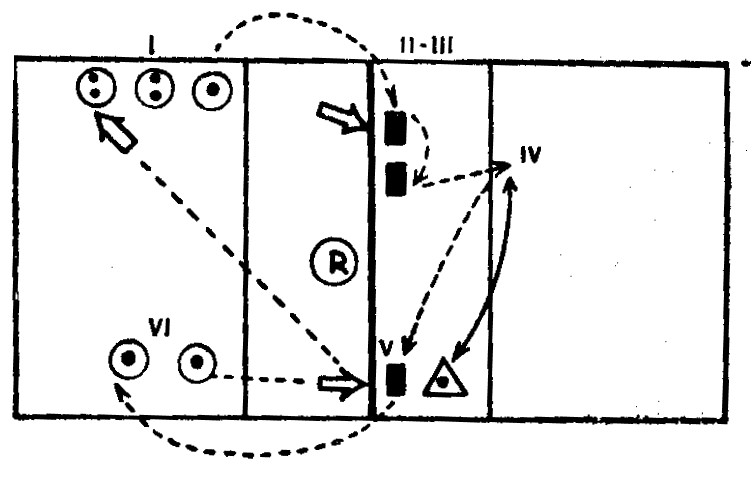Abstract
Problem: Puberty age is considered the age of the first performances. Due to the mobility of cortical nerve processes and their functional ability, the rapid alternation of excitation and inhibition occurs in the motor areas of the cortex, which ensures synchronised contraction and relaxation of the muscle groups with contradicting actions, the right responses to excitations. So, physical training must be adapted to different age categories applying methods and means proper for these categories. Purpose: The research purpose is to optimise the training process of volleyball players in order to improve specific and general resistance. Premises: By using methods, techniques and specific means adapted to particularities of junior II players, the intended goals will be accomplished and consequently the quality of motor resistance specific to volleyball game will be improved. Research methods: bibliographic documentation; observation; motor testing; statistical and mathematical method; graphical method. Discussion and conclusions: By the end of this period, after the age of 15, special attention can be paid to the development of general resistance and specific speed resistance, based on the individualised training for setters - speed resistance, and for spikers - jump resistance. Specific training is done relying on general training. In the volleyball game, for each training period, complex methods have also to be set. Their percentage depends on the training period, players’ particularities, main goals, etc. The selected ways for accomplishing the goals have been efficient, well dosed, which is highlighted by the progress obtained and the quality of executing the technical procedures.
Keywords: Specific resistance, juniors, volleyball game
1. Introduction
Contributing to health maintaining, to a harmonious development of the body, to develop some
body qualities necessary for human activity and also to obtain sports performances, physical training is
deemed to be an essential factor for sports and physical education activities.
Puberty age is considered the age of the first performances. Due to the mobility of the cortical nerve
processes and their functional ability, the fast alternation of excitation and inhibition occurs in the
motor areas of the cortex, which ensures synchronised contraction and relaxation of the muscle groups
with contradicting actions, the correct responses to excitations.
Multilateral physical training underlies specific physical training. Without multilateral physical
training, specific physical training cannot be accomplished under optimal conditions.
In the first training periods of the volleyball player, multilateral physical training has an important
share (Cojocaru & Cojocaru, 2009: 64). This training is uninterrupted in the next periods, including
high performance athletes, of course with a lower share.
The orientation of the physical training has to be made considering the other training components
(technical, tactical and mental ones), its contribution to consolidating and harnessing the technical-
tactical efficiency being special. It becomes obvious the necessity of applying the principle of
concentric training (Bril & Kleshev, 1988: 84).
Physical training has to be adapted to different age categories by applying proper methods and
means.
Resistance is the actuating quality by which physical effort is performed for a long time, without
decreasing its efficiency. In the game, the volleyball player performs a big number of rapid movements
(starts, stops, ball hitting) combined with repeated jumps for attacking and blocking actions, acyclic
movements made in rounds of intense effort and interspersed with short breaks.
Repeating these rounds too many times in a game needs specific training resistance. Resistance has
to be prepared according to the intensity and duration of the effort. To obtain special results in
developing resistance, it is necessary to apply a variety of methods and ways.
Rapid execution of a movement series in which technical procedures are simulated by applying a
focused game (without breaks, in which the “out of play” ball is replaced with another ball when the
mistake has been made), or performing a number of technical-tactical actions within a time limit (for
example, 10 attack strikes within 30-40 seconds) by a player, are examples of ways used for
developing specific resistance.
1.1. The research hypothesis
We presume that, by using methods, techniques and specific ways adapted to the particularities of
junior players, the intended goals will be accomplished and hence the actuating quality of resistance,
specific to volleyball game, will be improved.
2. Materials and methods
During the experiment, the following research methods were used: bibliographic documentation;
observation; actuating tests; statistical and mathematical method; graphical method. The experiment
was performed with Dinamo Bucharest Men’s Volleyball team, players aged between 15-17 years. The
experiment was developed during one competition year (2013/2014) and had as goal the increase of
actuating indexes specific to junior volleyball players’ resistance.
The sample included in the research was composed of 24 volleyball players, junior category, a quite
large group, which can be explained by the three age categories:15, 16 and 17 years. During the
training period, all components of sports training were endorsed, but the emphasis was put especially
on physical training and consequently on resistance development. In May, control tests were again
applied in order to observe the progress compared to the first test, and also the differences between the
final result and the model presented by the Romanian Volleyball Federation for this age category. The
methods and means used were the ones recommended by the specialized literature.
By the end of this period, after the age of 15 years, special attention can be paid to developing
general resistance and specific speed resistance. Individual training can be performed for setters - speed
resistance, and for spikers - jump resistance. Specific training is done relying on the general training
(Bompa, 2003: 205).
Developing resistance presumes using many methods, because using only one it is not possible to
determine the corresponding effects (Baechle & Earle, 2000: 31). In fact, the outstanding results
obtained in athletic resistance tests show the usefulness of resorting to a wide variety of methods.
Method of variable training Hindering method Method of long-term effort Interval training Control method Tempo method Contest method Circuit training method
2.1. Selecting exercises
Exercises for specific resistance
game, several sets (6-10); game with a reduced number of team players; game at the end of the training under fatigue; game with reducing duration, number of sets, but with introducing some game fragments in a very
fast tempo;
the same, but when the game ends in sets with 4-0 or 3-1, it is decided by adding points, including the ones from very rapid game fragments;
game with handicap and reducing the duration of some sets; there are played five sets alternatively, each team starts with a five points advantage. It can be given pauses between the sets at team’s request;
4 to 4 normal game and with a thrown ball (combined); there are played 4 sets until 11, the usual odd, the even ones with a thrown ball. It will be considered the methodical guidelines provided at
the previous exercise.
3 to 3 game with common setter: the attack is made only beyond the attacking line. The setter moves beneath the net to help organise the attack of each team; the attack is made in a different
direction than the impetus (for advanced players), simulating the attack in the other direction. There
will be used short sets until reaching 11 points.
2 to 2 game with the same setter (for advanced players) is played on the whole court between the attack line and the end line. There will be used short sets, until 7 or 9 points. Four teams can play simultaneously on half of court-long divided;
Exercises for specific resistance of front-row players
Displacement by transversal jumps over the gym bench (timed) (Fig. 1);

Individual alternative blocking actions on areas 2 and 3, with a maximum number of trials established in a fixed amount of time. At the beginning, the working time will be 30 sec, gradually
increasing. It is executed by touching the ball held over the net (Fig. 2);

Repeated jumps in the same place, by touching maximum height; as many executions in 30-50 sec; a ball is placed or a sign is marked on the basketball backboard at the height of the maximum jump
without impetus, that the players must reach;
Circuit around the net, with front row actions, working on 5 workshops (Fig. 3):
workshop 1: two attacks from position 4;
workshop 2: two players in blocking action on opponent’s position 2;
workshop 3: players in backing movement from the net to the attacking line trying to receive the
ball from opposite attack hit;
workshop 4: blocking action in position 4;
workshop 5: attack hit in position 2;

3. Results
At the end of May, there were applied the final tests on somatic, actuating and technical tests, and
the results obtained were compared with the initial ones, registering progress, also with the model of
the Romanian Volleyball Federation, recording the differences. The results obtained were also analysed
from a statistical point of view, both initially and also finally.
4. Discussions and conclusions
On actuating level for extension, within the initial testing, the average value is 43.63cm, with a
standard deviation of 0.57cm. The coefficient of variation indicates a value of 1.30, which shows the
high degree of homogeneity of the experiment group.
The final test presents the average value of the experimental group, 47.13cm, and a standard
deviation of 0.64cm. The coefficient of variation indicates a value of 1.35, which demonstrates a high
degree of homogeneity.
For lateral displacement, within the initial testing, the average value is 20.04, with a standard
deviation of 0.11. The coefficient of variation indicates a value of 5.53, which shows the high degreeof
homogeneity of the experiment group and a deviation from the average of 0.04.
Final testing presents the average value of the experimental group, 25.54, and a standard deviation
of 1.30. The coefficient of variation indicates a value of 0.09, which demonstrates a high degreeof
homogeneity and a deviation from the average of 0.05.
In this test, the difference between the final result and model is 0.83 sec, which states that the
teacher has to insist more on developing actuating qualities.
During the match, the volleyball player performs a big number of rapid movements (starts,
displacements, stops, ball hits) combined with repeated jumps for attack and block actions, acyclic
movements made in rounds of intense efforts and interspersed by short breaks (Balaiş & Păcuraru,
1997: 92).
While there are several key elements in designing a weight training program for the volleyball
player, perhaps the most critical is improving the vertical jump. A well-designed program which does
this includes specific exercises for developing core strength while minimizing risk of injury. Core
strength includes not only the legs and back, but the abs as well (Fleck & Kraemer, 2004: 78).
While plyometrics is an exceptional way to improve the vertical leap, it requires a foundation of
strength to be built to be used effectively, and, once again, with far less chance of injury (Gonzales-
Badillo et al., 2005: 690). The most basic exercise to strengthen the connective tissue as well as build
an overall foundation of strength is the squat. For the first several phases of the program, it will be
done in a slow and controlled manner, to not only build strength but to teach proper form.
Therefore, increasing training volume does not always provide a better stimulus for improving
adaptations during a long-term competitive period (Hoff, Gran, & Helgerud, 2000: 290).
In the volleyball game, for each training period, the method complex has also to be set. Their share
depends on the training period, on the players’ peculiarities, on the main goals, etc.
It is recommended to use many methods: interval, circuit, variable training, tempo, control methods.
According to tasks, the means used and the training period, some methods can prevail over the others.
The effort made by front-row players is anaerobic, and for the back-row players the effort is aerobic,
so the training of specific resistance has to take also into consideration this aspect. To obtain special
results in developing the resistance, it is necessary to apply a wide variety of ways and means.
By the end of this period, after turning 15 years old, special attention can be paid to developing
general resistance and specific speed resistance, based on the individualized training for setters – speed
resistance, and for spikers – jump resistance. Against the background of general training, it is
performed specific training. It is observed a visible progress between the two tests, which demonstrates
that the training process was well-planned and organised, and the most efficient teaching tools were
used. The selected means for accomplishing the goals have been efficient, well dosed, which is
highlighted by the progress obtained and the quality of executing the technical procedures.
References
Balaiş, F., & Păcuraru, Al. (1997). Volei - de la selecţie la performanţă. Galaţi: Editura Academica. Baechle, T. R., & Earle, R. W. (2000). Essentials of Strength Training and Conditioning (2nd edition).
Champaign, IL: Human Kinetics.
Bompa, T. (2003). Performanţa în jocurile sportive: teoria şi metodologia antrenamentului. Bucureşti: Ex
Pronto.
Bril, M. S., & Kleshev, U. N. (1988). Modelling characteristics usage of top skills volleyball players during
sports schools selection. М: IFK.
Cojocaru, A., & Cojocaru, M. (2009). Volei - antrenament şi performanţă. Bucureşti: Bren.
Fleck, S. J., & Kraemer, W. J. (2004). Designing Resistance Training Programs (3rd edition). Champaign, IL:
Human Kinetics.
Gonzales-Badillo, J. J., Gorostiaga, E. M., Arellano, R., & Izquierdo, M. (2005). Moderate resistance training volume produces more favourable strength gains than high or low volumes during a short-term training cycle. J Strength Cond Res., 19(3), 689-697.
Hoff, J., Gran, A., & Helgerud, J. (2000). Maximal strength training improves aerobic endurance performance. Scand Med Sci Sports, 12(5), 288-295.
Copyright information

This work is licensed under a Creative Commons Attribution-NonCommercial-NoDerivatives 4.0 International License.
About this article
Publication Date
10 June 2016
Article Doi
eBook ISBN
978-1-80296-010-5
Publisher
Future Academy
Volume
11
Print ISBN (optional)
-
Edition Number
1st Edition
Pages
1-509
Subjects
Sports, sport science, physical education
Cite this article as:
Cojocaru, A., & Cojocaru, M. (2016). Development of Specific Resistance in Junior Volleyball Players. In V. Grigore, M. Stanescu, & M. Paunescu (Eds.), Physical Education, Sport and Kinetotherapy - ICPESK 2015, vol 11. European Proceedings of Social and Behavioural Sciences (pp. 334-340). Future Academy. https://doi.org/10.15405/epsbs.2016.06.46

